Chapter 2
Background
Introduction
2.1
This chapter will provide a background to the inquiry including the
increasing use of military unmanned platforms, use of unmanned aerial vehicles
(UAVs) by the United States (US), the proliferation of UAV capability and ADF
use of unmanned platforms.
Terminology
2.2
While popularly referred to as 'drones', unmanned platforms are an area
of defence technology rich in acronyms and abbreviations. The range of terminology
has been increased by a differing focus on the unmanned vehicle/unit itself and
the associated systems of communication and control. In particular, the numbers
and categories of UAV (also referred to as remotely piloted aircraft (RPA) or
unmanned aircraft systems (UAS)) have soared in recent years. For convenience,
the term 'unmanned platform' has been used in the committee's report to refer
to all complex remotely operated devices and their associated communication and
control systems.
Unmanned platforms
2.3
Unmanned platforms often have a number of common characteristics. These
include the structure of the platform itself, the external control system (such
as a ground control station), the communications system which links to the control
system, and the payload (which could include sensors or munitions). Automated
functions are also often incorporated such as waypoint navigation via GPS.
Figure 2.1. Visualisation of UAV communications.[1]
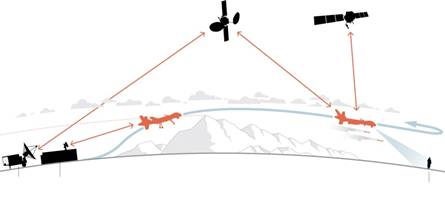
2.4
There are differing views on the first uses of unmanned platforms in a military
context.[2]
Notably, in the 1950s, the Australian Government Aircraft Factory produced
advanced 'target drones' (the GAF Jindivik) as part of an agreement with the
United Kingdom (UK) for guided missile testing. The Defence submission observed
that the popular term 'drone' may originate from the striped painted fuselage of
aerial targets.[3]
However, the first modern use of unmanned platforms is frequently identified as
the US use of the Ryan Fire Fly and Lightning Bug (Teledyne, US) high altitude
unmanned jets over South East Asia and North Vietnam in the early 1960s.[4]
These were target drones designs adapted for long range surveillance over
conflict zones.
UAV use by the United States
2.5
Since 2001, the US has attacked hundreds of targets in Afghanistan, Northwest
Pakistan, Yemen and Somali using armed medium altitude long endurance (MALE) UAVs
as part of counter-terrorism operations.[5]
Some of these operations have been criticised by human rights groups and others
in relation to their legality and the number of civilian casualties associated
with these attacks. For example, the Programme on the Regulation of Emerging
Military Technology (PREMT) submission notes that the 'rather extensive armed
UAV programme of the US has proven to be highly controversial, engendering
significant public debate in the US and provoking widespread discontent in the
countries in which the aircraft operate'.[6]
Statements by US President Barack Obama on 23 May 2013, at the National
Defense University in Washington, have been reported as signalling a shift
policy to reducing the number of armed UAV strikes conducted by the US.[7]
Proliferation of UAV capability
2.6
Australia, and many other developed countries, are partners to a number
of defence technology export regimes which can cover certain unmanned
platforms. For example, the Missile Technology Control Regime (MTCR) is an
informal and voluntary association of 34 nations which seeks to coordinate
national export licensing efforts aimed at discouraging the proliferation of
unmanned delivery systems capable of carrying weapons of mass destructions.
Other countries such as Israel, India and China have indicated they will abide
by the rules of these defence export control regimes to varying degrees.
2.7
Nonetheless, advanced unmanned platforms (many capable of being armed)
appear to be proliferating. In the US, there has been internal debate about the
appropriate defence export controls on military UAVs.[8]
US sales of armed UAVs have been limited to the United Kingdom (UK), although
other countries have purchased large unmanned systems. On 17 February 2015, the
US State Department announced a 'new policy, governing the international sale,
transfer and subsequent use of US-origin military UAS' as part of a 'policy
review which includes plans to work with other countries to shape international
standards for the sale, transfer, and subsequent use of military UAS'. It
noted:
The new policy also maintains the United States'
long-standing commitments under the Missile Technology Control Regime (MTCR),
which subjects transfers of military and commercial systems that cross the
threshold of MTCR Category I (i.e., UAS that are capable of a range of at least
300 kilometers and are capable of carrying a payload of at least 500 kilograms)
to a "strong presumption of denial" for export but also permits such
exports on "rare occasions" that are well justified in terms of the
nonproliferation and export control factors specified in the MTCR Guidelines.[9]
2.8
Under the new policy, the US will require recipients to agree to
principles guiding the proper use of US-origin military UASs:
Recipients are to use these systems in accordance with
international law, including international humanitarian law and international
human rights law, as applicable;
Armed and other advanced UAS are to be used in operations
involving the use of force only when there is a lawful basis for use of force
under international law, such as national self-defense;
Recipients are not to use military UAS to conduct unlawful
surveillance or use unlawful force against their domestic populations; and
As appropriate, recipients shall provide UAS operators
technical and doctrinal training on the use of these systems to reduce the risk
of unintended injury or damage.[10]
2.9
The development of cheaper UAVs suitable for intelligence, surveillance
and reconnaissance (ISR) has meant they have become available to almost all
modern militaries at the lower end of capability. Although the US, UK and Israel
are the main users of armed UAVs, other countries such as Russia, China, Iran, India,
South Korea and Taiwan, for example, have begun to develop increasingly
sophisticated unmanned platform capabilities. Other countries, including
Pakistan, Turkey, Saudi Arabia and the United Arab Emirates (UAE) have
announced their intention to acquire them.[11]
Northrop Grumman commented:
In a global context, use of unmanned systems continues to
grow at a rapid pace – the last decade seeing an exponential increase especially
in UAS, primarily performing ISR missions, and with increasing use in command
and control, communications relay, battlespace awareness, force protection,
ordnance delivery and logistics.[12]
2.10
A Council of Foreign Relations report in 2014 on armed UAVs noted:
According to industry estimates, international interest in
armed drones has grown in the wake of Iraq and Afghanistan. The drone market is
expected to grow from [US]$5.2 billion in 2013 to [US]$8.35 billion by 2018. While
drones are still a relatively small portion of the overall defense market, the
segment with the "biggest potential" is the demand for
medium-altitude long-endurance (MALE) drones, such as the Predator and Reaper.[13]
2.11
Increasingly, UAVs have been perceived as an important sovereign capability.
For example, in May 2015, Italy, Germany and France announced an agreement to commence
a MALE UAV development program. The German Defence Minister, Ursula von der
Leyen, was reported as commenting:
The goal of the Euro-drone is that we can decide by ourselves
in Europe on what we use it, where we deploy the Euro-drone and how we use it...
This makes us, the Europeans, independent.[14]
2.12
A recent report to the US Congress on military and security developments
in China has indicated that it was 'advancing its development and employment of
UAVs':
Some estimates indicate China plans to produce upwards of
41,800 land and sea-based unmanned systems, worth about [US]$10.5 billion,
between 2014 and 2023. During 2013, China began incorporating its UAVs into
military exercises and conducted ISR over the East China Sea...In 2013, China
unveiled details of four UAVs under development—the Xianglong, Yilong, Sky
Saber, and Lijian—the last three of which are designed to carry
precision-strike capable weapons.[15]
Stealth, combat and autonomy
2.13
Research and development in relation to large military UAVs appears to
have moved from focusing on platforms intended to operate in non-contested
airspace to platforms designed to operate in contested or denied airspace. The
focus on these types of unmanned platforms is arguably driven by advances in
the anti-access/area denial (A2/AD) capabilities of other countries. A2/AD
capabilities include anti-aircraft and anti-ship missile systems which could
potentially prevent aircraft and carrier fleets from approaching strategically
significant areas.
2.14
Some of these new unmanned platforms rely on low-observability, high
manoeuvrability, hypersonic flight and increased levels of autonomy from remote
operators. For example, the Taranis Unmanned Combat Air Vehicle (UCAV) (UK Ministry
of Defence/BAE Systems) demonstrator incorporates stealth technology and is
designed for long range missions. The Taranis is described as having 'full
autonomy' elements.[16]
Similarly, the US Navy X-47B demonstrator (Northrop Grumman, US) is another stealth-focussed
UCAV platform designed to be launched from an aircraft carrier. This is one
design of the US Navy's Unmanned Carrier-Launched Airborne Surveillance and
Strike (UCLASS) program. As currently envisioned UCLASS UAVs will have 'deterministic
autonomy' within pre-set parameters such as decisions on when to conduct aerial
refuelling.[17]
China is also reportedly developing stealth-focused UAVs.[18]
Figure 2.2 Taranis UCAV demonstrator[19]
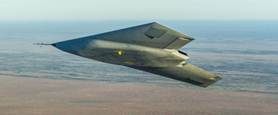
2.15
The line between unmanned platforms and guided munitions is also being
blurred. For example, the Harop (IAI, Israel) is a long range 'loitering
munition', controlled in-flight by a remote operator, designed to detect and
attack air defence radar systems by self-destructing into them. Similarly, the
Switchblade (AeroVironment, US) is an expendable small UAV equipped with an
explosive warhead which has been used by US Marines in Afghanistan.
Counter-UAV research focus
2.16
As unmanned platforms have proliferated as a component of military
arsenals around the world, research has increasingly focused on developing
effective counter-UAV technologies. Some commentators have highlighted that
small low-cost civilian 'drones' are already being utilised by non-State actors.
For example, on 17 March 2015, US Central Command noted an
airstrike by US and Coalition forces destroyed 'an [Islamic State] remotely
piloted aircraft' for the first time in Iraq.[20]
The RAND Corporation's report on UAVs commented:
The availability of this technology means it is likely that
states hostile to the United States will acquire it in the foreseeable future.
They could use it for suppression of internal enemies, or to support ground combat
units, the way the United States uses it today. This is not an insurmountable
threat to U.S. operations, but the United States is not yet prepared to deal
with it. Current U.S. doctrine for short-range air defense is primarily
concerned with defeating attacking helicopters with missiles. The United States
may have to develop new defensive systems as the threat from small UAVs
emerges.[21]
2.17
Similarly, the Sir Richard Williams Foundation has recently argued that
'defensive capabilities must also be developed in case such systems are used
against Australia and Australian forces'.[22]
2.18
In the US, there have been a number of recent developments in
counter-UAV research. Last year, the US Navy demonstrated a ship-mounted
directed energy weapon system, including against a UAV target.[23]
The US Joint Integrated Air and Missile Defense Organization has arranged a counter-UAV
demonstrator event focused on adapting existing and new air defence
capabilities to UAV threats.[24]
The US Army last year issued a 'request for information' on counter unmanned
aerial system capabilities. It observed:
US FORCES will be increasingly threatened by reconnaissance
and armed Unmanned Aerial Vehicles (UAVs) in the near and far future. These
threats can be employed against all echelons of US FORCES. These threats do or
may employ a variety of sensors and operate at a variety of tactical levels.
These levels include micro sized to large UAVs and operate with varying
altitude and speed.[25]
Increasing development of ground, surface and undersea vehicles
2.19
Research and development in relation to unmanned platforms is also
extending to unmanned ground vehicles (UGVs), unmanned surface vehicles (USV)
and unmanned undersea vehicles (UUVs). This is illustrated by a number of
projects including:
-
the US Defense Advanced Research Projects Agency (DARPA) has
funded the development of the Legged Squad Support System, a quadruped robot
which can be controlled by voice command and is designed to function as a
packhorse for troops;
-
the Guardium (IAI/Elbit, Israel) is a four-wheel medium size
surveillance UGV Force equipped with cameras, sensors and a loud speaker used
by the Israeli Defence for border patrol duties;
-
the Protector (Rafael, Israel) is a USV based on a rigid-hulled
inflatable boat which can be armed. The Protector has been deployed by the Israeli
Defence Force and Republic of Singapore Navy; and
-
the Remus (Kongberg, Norway) is a UUV remotely operated from a
laptop which has been used for mine clearance.[26]
Figure 2.3 Guardium
UGV[27]
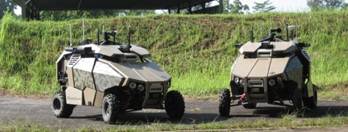
ADF use of unmanned platforms
2.20
The ADF has previously used unmanned platforms in a number of contexts. However,
these utilisations have not involved the use of force. The Defence submission
noted that '[a] number of Defence Capability Plan (DCP) projects and other
projects are presently focused on unmanned capabilities; however, the DCP does
not currently contain a project to procure an armed unmanned platform or
system'.[28]
Unmanned Ground Vehicles
2.21
The Australian Army has used several UGVs mainly focused on explosive
detection and removal. For example, the ADF has purchased and utilised Talon
UGV in Afghanistan. This platform has been used for disposal of improvised explosive
devices (IEDs), reconnaissance, the identification of hazardous material and
combat engineering support. The Defence submission noted that 'Project Land
3025 is focused on investigating and procuring additional UGV or UAS to support
explosive ordnance search and disposal'.[29]
Unmanned Surface Vehicles
2.22
Defence outlined that the 'Navy does operate unmanned surface (on water)
vehicles (USV) in the Fleet training support role, where this capability is
focused on the reduction of risks to personnel and the provision of increased
training fidelity'. It described these USV capabilities as 'human-in-the-loop'
controlled.[30]
Unmanned Undersea Vehicles
2.23
The Royal Australian Navy (RAN) Huon class mine hunters are equipped
with Double Eagle (Saab, Sweden) tethered remote operating vehicles, primarily
intended for the disposal of naval mines. The vehicle's payload can consist of
scanning sonar, echo locations, or self-navigation systems and have an extendable
manipulator arm which can be used to place a small explosive charge on a naval mine.
2.24
The Defence submission noted that Project SEA1778 'seeks to acquire
autonomous underwater vehicles for mine detection and classification,
expendable mine neutralisation systems for mine identification and disposal,
and unmanned surface vehicles for towing the in-service influence minesweeping
equipment'.[31]
It also stated that 'autonomous underwater vehicle (AUV) systems have been used
for experimentation in hydrographic survey and clearance diving tasks'.[32]
Figure 2.4 – Double Eagle UUV[33]
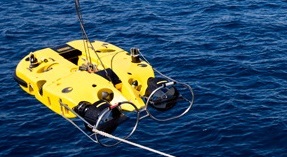
Unmanned Aerial Vehicles
Tactical UAV
2.25
The ADF has used tactical UAVs to support operations in Iraq and
Afghanistan, in particular, the Skylark (Elbit Systems, Israel) and the RQ-11
Raven (AeroVironment, US). These are 'miniature' light weight short range UAVs which
are launched by hand and usually equipped to provide 'over the horizon' ISR. The
ADF has recently commenced training with the RQ-12 Wasp (AeroVironment, US).[34]
The Defence submission noted the RAN is presently reviewing options for a
small, tactical UAS to be employed in the provision of ISR for counter-piracy
operations.[35]
Figure 2.5 Skylark UAV launch[36]
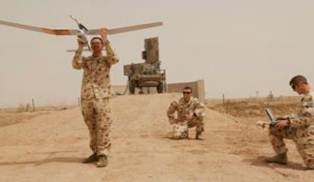
Heron
2.26
The Royal Australian Air Force (RAAF) currently operates the Heron UAV (IAI,
Israel) from RAAF Base Woomera for training purposes. Australia's Heron UAVs
completed more than 27,000 mission hours in Afghanistan and provided high
resolution ISR support to Australian forces and the International Security
Assistance Force in southern Afghanistan. Australia's Heron detachment in
Afghanistan flew its final mission for Operation SLIPPER from the Kandahar Air
Field on 30 November 2014. The Defence submission noted:
In October 2014, the former Minister for Defence announced
that Air Force would be returning a limited Heron-1 capability to Australia
following the end of its mission in December 2014. Australia will operate two
Heron-1 platforms in Australia to support the integration of complex UAS into
the Australian environment. The repatriation will also support the retention
and development of tactics and procedures for overland ISR gained during four
years of Heron operations in Afghanistan.[37]
Figure 2.6 – Heron UAV[38]
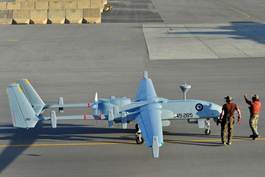
Shadow
2.27
The RQ-7 Shadow (AAI, US) tactical UAV has been used by the Australian
Army 20th Surveillance and Target Acquisition Regiment for reconnaissance,
surveillance, target acquisition and battle damage assessment. The Defence
submission noted the Shadow had been 'employed extensively in Afghanistan, has
been typically tasked in route reconnaissance, point reconnaissance and surveillance
flights to monitor "pattern of life" activities using sensors such as
electro-optic and infrared cameras. It stated that '[l]ike the United States
Army, the Australian Army utilises its soldiers to operate the Shadow 200,
which is different to the Australian Air Force, who employ qualified pilots to
operate the Heron-I'.[39]
2.28
The Defence submission outlined that the 'Joint Project (JP) 129 will
continue to support and update the Shadow 200 UAS capability as used in
operations in Afghanistan predominantly by ground forces' and 'the project will
also seek to procure small tactical UAS capabilities to support tactical ISR'.[40]
Figure 2.7 – Shadow UAV launch[41]
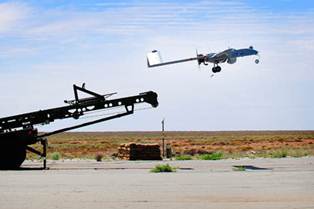
Triton
2.29
On 13 March 2014, the Prime Minister committed the Australian Government
to acquiring the MQ-4C Triton (Northrop Grumman, US) for use by the ADF. The
Prime Minister's media release noted that '[t]he total number of Triton UAVs to
be acquired and their introduction into service date will be further considered
by Government in 2016, based on the Defence White Paper'.[42]The
Tritons will be based at RAAF Base Edinburgh in South Australia and will
operate from the runway alongside the manned P-8A Poseidon maritime
surveillance aircraft when it enters RAAF service. The MQ-4C Triton will
operate alongside the P-8A Poseidon to replace the current AP-3C Orion
capability.
2.30
The Defence submission noted that the 'Triton is an unarmed UAS that is
capable of High Altitude Long Endurance (HALE) flight, as well as being
tactically agile to descend to medium altitudes as required' and will be fitted
with radar, electronic support and electro-optic sensors.[43]
Reaper training
2.31
The Defence submission stated:
Air Force is considering a program to fund the embedding of
ADF members into 'allied' UAS units. This activity will inform the ADF of the
support and operational characteristics of complex UAS systems, as operated by our
close allies, should the ADF seek to acquire similar systems in the future.[44]
2.32
On 23 February 2015, the Parliamentary Secretary to the Minister for
Defence, the Hon Darren Chester MP, announced that the RAAF had commenced
training aircrew and support staff on MQ-9 Reaper (General Atomics, US)
operations in the United States. The media release stated 'the training program
provides a cost effective method to increase the ADF's understanding of complex
UAS operations and how this capability can be best used to protect Australian
troops on future operations'.[45]
At the April public hearing, Defence confirmed six RAAF personnel were
undertaking Reaper training in the US.[46]
Figure 2.8 – US Reaper UAV[47]
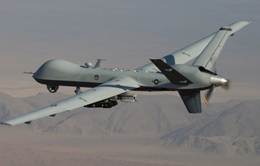
Navigation: Previous Page | Contents | Next Page